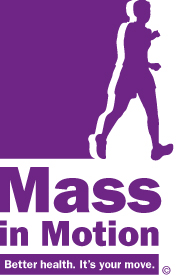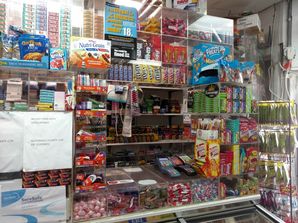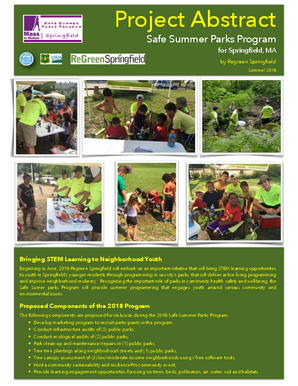Mass In Motion
Mass in Motion Program Overview

Mass in Motion is a statewide public health initiative that promotes policies, systems level changes, and environmental changes aimed at increasing access to healthy eating and active living opportunities for people who live, work, and play in communities around the Commonwealth of Massachusetts. It was started in 2009 primarily in response to rising concerns around obesity but is broadly focused on improving health outcomes and reducing rates of chronic disease across the state while improving health outcomes and reducing rates of chronic disease across the state while improving quality of life for residents and reducing long term healthcare costs across the state as a result. Here in Springfield, our Mass in Motion initiative is housed in the Department of Health and Human Service; the Mass in Motion coordinator for Springfield works at the direction of the Commissioner.
Creating healthy environments cannot be done in isolation by any one organization; it requires coordinated efforts on multiple parts. This important work can only be accomplished by bringing together a cross-section of agencies and organizations including municipal government, schools, health centers, hospitals, public safety, and community based organizations and others to address this community's needs in a comprehensive way. Community partners working together to uplift the Mass in Motion mission include: Springfield Parks Department, Springfield Office of Planning and Economic Development, Springfield Department of Public Works, LiveWell Springfield, Pioneer Valley Planning Commission, Springfield Food Policy Council, Springfield Public Schools, Department of Elder Affairs, Caring Health Center, The Food Bank of Western Mass, YMCA of Greater Springfield, Wayfinders.
Some neighborhoods in the City of Springfield lack access to full line large scale grocery store that provides quality, affordable, culturally appropriate fresh foods and produce options. Many residents of the city with lower socioeconomic status living in these neighborhoods also lack transportation or access to a reliable vehicle to get them to grocers in other neighborhoods. As such, many low income residents throughout the city rely on convenience stores or corner stores as a primary point of food access, given how proximal many of them are to thickly-settled housing and residential areas.
Healthy eating and active living: What are projects we're working on?
Staff and contact information:
Benjamin Bland, Program Coordinator, 413-750-2720(p); 413-787-6458(f); bbland@springfieldcityhall.com
What are we working on?

Healthy Retail
Some neighborhoods in the City of Springfield lack a full line large scale grocery store that provide quality, affordable, culturally appropriate fresh foods and produce options. Many residents of the city with lower socioeconomic status living in these neighborhoods also lack transportation or access to a reliable vehicle to get them to grocers in other neighborhoods. As such, many low income residents throughout the city rely on convenience stores or corner stores as a primary point of food access, give how proximal many of them are to thickly-settled housing and residential areas.
The large majority of convenience stores are not currently offering healthier options such as: chopped and prepared fruit cups, whole fruits, skim and 2% milks, viable milk alternatives such as almond or soy, 100% Juice, cereals that feature whole grain, whole grain and whole wheat bread products, whole grain snack bars, yogurts, healthier snack options such as nuts and baked chips, or fruits and vegetable of the fresh/frozen/canned/dried variety. This can be attributed to a myriad of reasons including but not limited to: they don't know how to store it or display it properly, the cost of produce is high, shelf life of perishables is low, they lack square footage, lack of buy in from building owners and landlords to make capital improvements or they lack the infrastructure and equipment to have the capacity to sell produce even if they want to.
When we think about healthy retail, we're trying to think about every point of interaction that a food vendor has with the community where it's operating. A comprehensive look at healthy retail is thinking about things like physical footprint and use of space (bright, clean, inviting, and well-lit attractive spaces), usage and perception by the community (what need is this store filling for the community and what is their perception of the store?), workforce development, SNAP/WIC compliance, public safety and accessibility, and health and wellness (healthier products and a varied product mix). The Springfield healthy retail group is a newly formed multi-sectoral group of stakeholders that has met multiple times to troubleshoot around this issue.
Safe Summer Parks

Springfield Wellness Council Leadership bios
Names and Bios of Springfield's Wellness Council Leadership